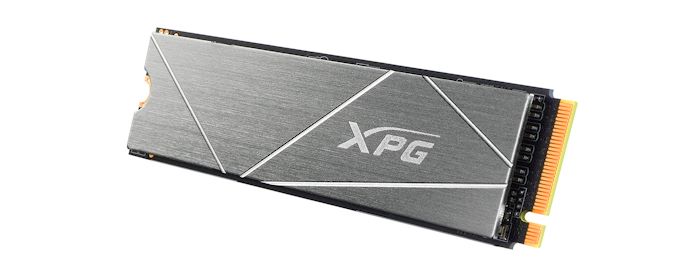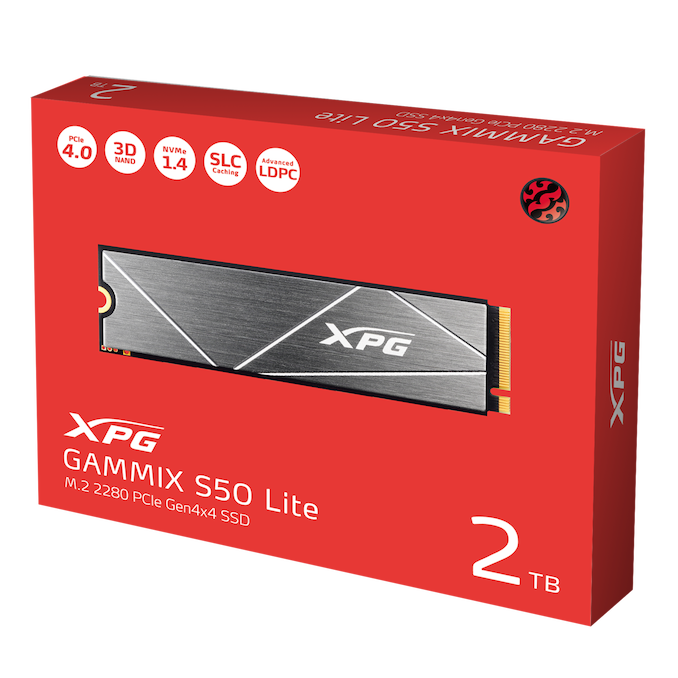ADATA XPG Launches a PCIe 4.0 x4 NVMe SSD for Notebooks: Gammix S50 Lite
by Dr. Ian Cutress on September 18, 2020 5:00 PM EST
One of the primary issues with most of the PCIe 4.0 NVMe storage drives on the market today is power consumption. The only base solution for OEMs in the market, for 6+ months, can consume up to 5-8 W when in use. This is due to the SSD controller that was originally built for PCIe 3.0 work and not optimized when it was updated for PCIe 4.0. However, as that design was first to market and works in desktops it does what it needed to do. But for laptops, we’ve been waiting on the optimized follow ups. The new ADATA Gammix S50 Lite will use one of those optimized designs.
A Second Wave of PCIe 4.0 SSDs
The first PCIe 4.0 drives on the market used the Phison E16 controller which was, for lack of a better word, a hybrid design: it took the PCIe 3.0 E12 controller, removed the PCIe 3.0 part, and added in PCIe 4.0 connectivity. A controller involves both the connection standard and a compute segment, and the compute segment was not updated in order to enable the product to come to market very quickly. As a result, even though the compute could handle PCIe 4.0, it wasn’t optimized for it, but we had some power hungry drives to play with for a while.
Since then, we have been waiting for the second wave of PCIe 4.0 controllers to come to market. Samsung is making way with its new Elpis controller in the Samsung 980 Pro, and Phison’s own next-gen E18 is expected to come to market later this year, while the E19 has been teased at a couple of industry events. These controllers are all set to offer better performance or better efficiency for the wider adoption of PCIe 4.0 SSDs.
Then there are also SMI controllers, and both SMI and its OEM partners have teased new PCIe 4.0 SSD turnkey designs as early as Computex 2019. At CES this year ADATA teased two PCIe 4.0 drives built with new SMI controllers: a high performance model with the SM2264 for desktops, and a medium performance efficiency model with the SM2267 for notebooks. The SM2267 is what is going into the new Gammix S50 Lite SSD being launched today.
The Gammix S50 Lite
The new drive might not sound like much in the performance stakes, with only 3900 MB/sec read and 3200 MB/sec writes, as well as 490K/540K IOPs, but as a PCIe 4.0 drive it is much faster than a PCIe 3.0 drive and ADATA claims that due to the design it can be up to 20% cooler (in temperature) than other competitive offerings.
This drive uses a four-channel design rather than 8, which goes someway into explaining the performance and the potentially lower power consumption, but it also has a DRAM cache buffer and SLC caching to help with keeping performance high. What all of this comes down to is making the drive more suitable for installation in upcoming PCIe 4.0-enabled laptops featuring Tiger Lake processors.
The Gammix S50 Lite will come in 1 TB and 2 TB capacities initially, offer LPDC error correction, RAID engine support, and AES 256-bit encryption. The drive has a 5 year warranty, and both models are rated to 1480 terabytes written (TBW). The drives will be available in North America from October 1st, with the following pricing:
- XPG Gammix S50 1 TB: $150
- XPG Gammix S50 2 TB: $300
At these prices, the 1 TB model is $15-$50 cheaper than the E16 PCIe 4.0 drives on the market.
Source: ADATA Product Page
Related Reading
- CES 2020: ADATA Preparing Three PCIe 4.0 Consumer SSDs
- Got a Spare $10,000? Here’s Your Keyboard: ADATA’s 24K Gold Design
- The ADATA XPG SX6000 Pro 1TB SSD Review: Realtek's Entry-level NVMe Solution
- ADATA Releases the XPG SX8100 SSD: Make It Fast & Hold the Bling
- ADATA Launches XPG Gammix S50: A PCIe 4.0 x4 SSD
- ADATA Shows Off SMI’s Prototype PCIe 4.0 x4 512GB SSD: An SM2267 SSD











15 Comments
View All Comments
Makaveli - Friday, September 18, 2020 - link
TBW 1480 much better than the 600 of the Samsung 980 Pro drive.vladx - Friday, September 18, 2020 - link
Like you'd get to write even 100TB, anyways Samsung drives are known to surpass official endurance numbers by a lot.Quantumz0d - Friday, September 18, 2020 - link
Doesn't mean jack shit when their basic endurance falls short by almost all of the SSD makers except their top MLC, 860 Pro lineup. Samsung Drive on the PRO = MLC, the moment they drop that it's irrelevant to pay Samsung Tax.They shot themselves in the foot with the TLC b.s on their top end line. Corsair, XPG, WD, Micron, Sabrent all of them use TLC and get higher TBW for their drives.
eek2121 - Saturday, September 19, 2020 - link
I mean, it kind of means everything. If I told you that you could eat 5.5 lbs (2.5 kg) of pizza for $10 or 10 lbs (4.5 kg) for $30, which would you choose? especially knowing that realistically you will only eat half of the cheaper option.Note that a single TB written does not equal a TB of drive writes. I have written 100TB to my 1TB Samsung EVO NVME drive, but thanks to wear leveling the life is still 96%.
MDD1963 - Monday, September 21, 2020 - link
I'm at a whole 30 TBW of writes in 3.3 years of desktop usage on a 960 EVO, as a point of comparison in what I consider 'typical desktop usage'... 600 TB vs. 1000 vs. 2000...all just 'feel good' numbers as the 5 year warranty will be gone after only about 50 TB anyway.... (Having a hypothetical 500 vs. 1000 TB of 'good for at least' writes remaining seems trivial...)TheJian - Saturday, September 26, 2020 - link
My boot SSD only has 40 in about the same. It says I only do 8.x TBW per year on that one; but the OS doesn't change much and run without a swap file, so it isn't getting hammered at all. But isn't used like the other and 1/2 size, so can't do much with it anyway for my usage patterns. Working with many things with massive GB's these days, just makes that drive useless for anything other than a boot disk really. There are many things though, that work from data on one drive, modify it and output it to another. Almost anything content creation related usually is done like this, (scratch drives etc). I'm sure downloaders hit SSD's like that too and probably idiots watching netflix etc stream all day to their only HD, which is a small SSD. Why do people watch TV on PC? Space constrained people I get (mobile home? small apt), but everyone else? No big TV?MeateaW - Sunday, November 8, 2020 - link
I ran a couple(read: 24) 512 gb samsung 960 evo's (the cheapest consumer SSD samsung had) in a raid array for about 5 years. That raid array had several exchange mailbox databases (4 TBs of email databases). Reading and writing constantly, no TRIM support in the raid controllers so pretty much worst case scenario for hte drives. Across all the drives we had maybe 4 dead cells (4 dead recovered cells mind you, no data loss).Some dude running a PC under his TV isn't going to come near the lifetime of their drive.
TheJian - Saturday, September 26, 2020 - link
I can write over 10TB in a day. I regularly do 2TB a day via various things. I only have a 6MB/s connection (that's ~60Mbit), but it can go all day 24/7 unlimited (biz line) and do all that over a vpn too. ;) If I could just get MSFT/Google to stop telling me I'm not me, I'd be golden...LOL They hate VPN's. You are ignorant if you think people can't hit these levels, and in many cases easily. I do direct portions of that away from the SSD just because I gain nothing from it at the time (conserve those writes when I can), but much goes there first for the speed etc. I'll be adding another 1TB drive, and will then be doing that type of crap to two of them (getting data to one, then changing it in some way shape/form and sending it to the other).So for some of us, that number actual means something.
TrevorH - Friday, September 18, 2020 - link
Th data sheet accessible off the link says that the 1TB version is rated for 740TBW and the 2TB for 1480TB. It also says "Power Consumption: 0.33W Active (Typical), 0.14W Slumber (Typical) (*measured by power meter)" though that sounds overly optimistic to me.MenhirMike - Saturday, September 19, 2020 - link
Kinda curious: Are internal PCIe lanes a concern for laptop design? That is, would there be a point to use PCIe4 x2 for a SSD (and possibly PCIe4 x4 for a dedicated GPU) to save board space while still offering "great enough" performance?